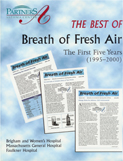Breath of Fresh Air: Feature Articles
Chapter 42: Does asthma ever turn into emphysema?
Asthma does not turn into emphysema. Although asthma and emphysema share some properties in common, including cough, shortness of breath, chest tightness, and difficulty emptying air from the lungs, they are different diseases. Emphysema is almost always due to cigarette smoking; asthma is more closely linked to allergies. Asthma most often begins in childhood; emphysema is rare before middle age. Symptoms of asthma come and go; shortness of breath on exertion is permanent in emphysema. Persons with well-controlled asthma can have a normal lung capacity; impaired lung function in emphysema never goes away.
Cigarette smoking damages the lungs in a very specific way in emphysema. It causes the lungs to lose their elasticity or springiness. When we breathe out, we rely on the springiness of the lungs to force the air out of our chest. In emphysema, some of that springiness has been destroyed by damage to the walls of the air sacs, and the lungs empty slowly no matter how forcefully we might use our muscles to force the air out. With continued cigarette smoking, the lungs slowly deteriorate. Over a period of many years, patients may become totally disabled. No medication can restore the normal springiness of the lungs.
Asthma is different. In asthma, emptying air from the lungs may become difficult when the bronchial tubes are narrowed by contraction of the bronchial muscles and allergic swelling of the walls of the air passageways. Medications are available to treat both of these problems. Bronchodilators cause the muscles to relax, and anti-inflammatory medications reduce the swelling of the tubes. With treatment, the bronchial tubes are restored to their normal size, and air can empty from the lungs at a normal rate.
There are occasional exceptions to this rule. In some persons with asthma, inflammation of the bronchial tubes can lead to permanent scarring, causing an irreversible narrowing of the tubes. When this happens, the lungs empty slowly even when the patient feels well and his or her asthma is quiet. The patient may experience shortness of breath on exertion every day. Although not emphysema, asthma with permanent scarring of the bronchial tubes begins to look in many ways similar to emphysema.
We do not know why on occasion some persons with asthma develop permanent scarring and narrowing of their bronchial tubes (sometimes referred to as "airway remodeling"). The problem seems to occur more often in patients with severe disease that has been inadequately treated over many years. Good asthma control, regular treatment with anti-inflammatory medication, and monitoring of one’s lung function over time appear to be the best preventive measures. And, of course, don’t smoke cigarettes!

